Superstorm Sandy One Year Later:
Can Salt Marshes Handle Effluent From a Failed Sewage Treatment Plant?
Barbara A. Branca
Introduction
In late October 2012, Hurricane Sandy caused significant damage to the New York Metro area, including the south shore of Long Island where infrastructure on the barrier islands and waterfront communities on the mainland was devastated and crippled. Perhaps no greater example was the failure of the Bay Park Sewage Treatment Plant in East Rockaway, NY, where Sandy’s storm surge sent nine feet of saltwater into the facility, causing extensive damage. The plant went offline for two days and an estimated 68 million gallons of raw sewage was released into the Western Long Island South Shore (WLISS) estuary. In the days following the storm, the facility began partially treating sewage by removing 70 percent of the solids and applying heavy chlorination. This partially treated sewage was released into the estuary for approximately seven weeks while repairs were being conducted. The plant treats 65 million gallons of sewage per day and serves 40 percent of Nassau County’s 1.35 million residents. Media attention from Hurricane Sandy damage has increased public pressure to improve the aging facility’s operations and protect the estuary.
New York Sea Grant funded research to measure if the ecosystem could handle the additional sewage and increase its capacity to serve as a “nutrient sink,” or if the enhanced nutrient loads would shift the ecosystem to an alternative state that perpetuates additional organic matter loading. The research team of
Chester Zarnoch,
Tim Hoellein and
Denise Bruesewitz hypothesized that temperature and the respiration rates of organisms in the sediment community would strongly influence nutrient cycling in the WLISS estuary.
New York Sea Grant Communications Manager Barbara Ann Branca accompanied the research team on their fourth sampling trip to the site in early November 2013.
Barbara Ann Branca’s Blog
November 2, 2013
It was pitch black at 6 AM when I met Chester Zarnoch, Tim Hoellein and Denise Bruesewitz at the West Marina off Lido Blvd in Point Lookout in the early morning of November 2, which was the last day of Daylight Savings Time. With Jim Browne, conservation biologist from the Town of Hempstead, at the helm of a 21-foot Carolina skiff filled to the gills with sampling equipment, we motored out in semi-darkness through Reynolds Channel just as the sun was coming up and arrived at the Bay Park Wastewater Treatment Plant.
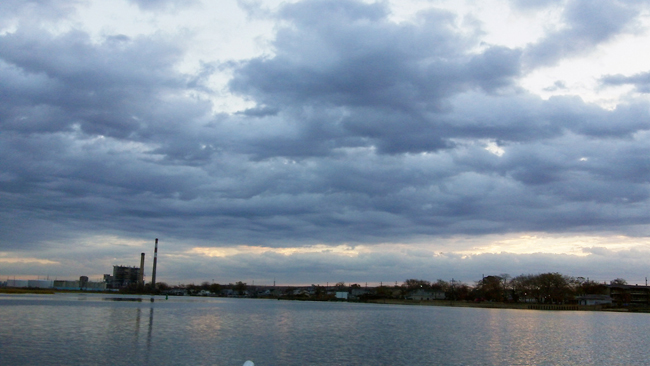
Early morning near the Bay Park Wastewater Treatment Plant on Long Island’s south shore. The plant, which serves 40 percent of populous Nassau County’s residents, failed during Superstorm Sandy, releasing raw sewage into the estuary.
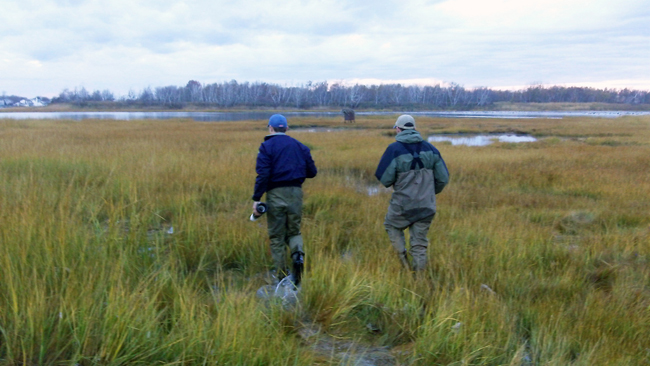 Dr. Chester Zarnoch
Dr. Chester Zarnoch of CUNY Baruch College and Dr. Tim Hoellein, Loyola University, Chicago, begin the trek out to the salt marsh for fall sampling.

In the shadow of the plant, co-investigator
Dr. Denise Bruesewitz of Colby College, and conservation biologist
Jim Browne await the first water samples of the day.
With our waders on, we trudged off into the salt marsh. I followed Chester and Tim as they collected the first core samples of the day from the same swath of salt marsh they visited back in January, April and again in July while Denise and Jim stayed in the skiff. The idea was to get multiple samples with 15 cm worth of sediment.
What a contrast. In the opposite direction from the plant as the sun came up turning the Spartina grasses golden, hundreds of brants (
Branta bernicula), cousins of Canada geese, were visible in the salt marsh and according to Jim, gorging themselves on the plentiful Ulva—sea lettuce—much needed after their long migration from above the Arctic Circle.
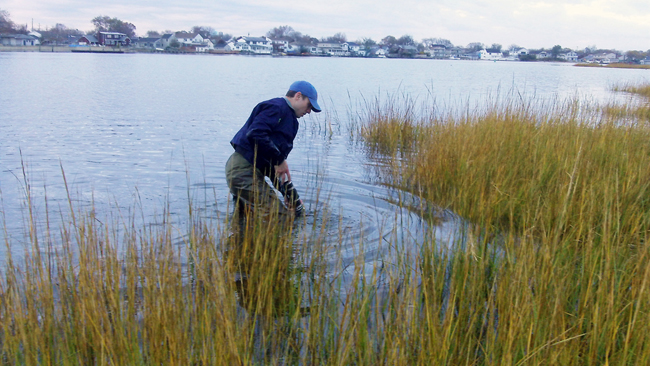
Chester Zarnoch gets the first sample of the day.
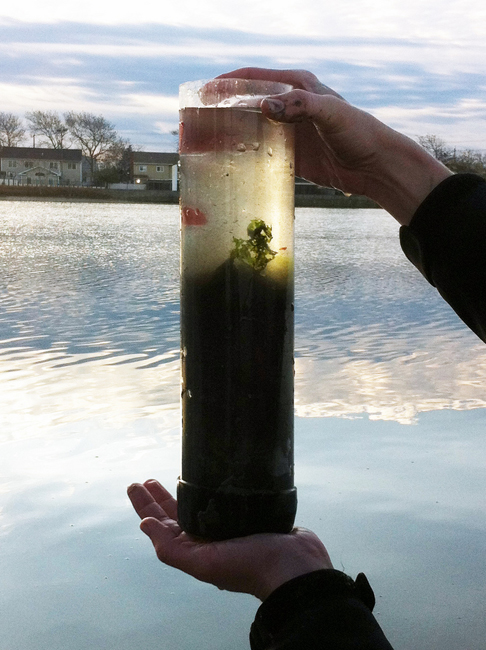
Early morning sample.
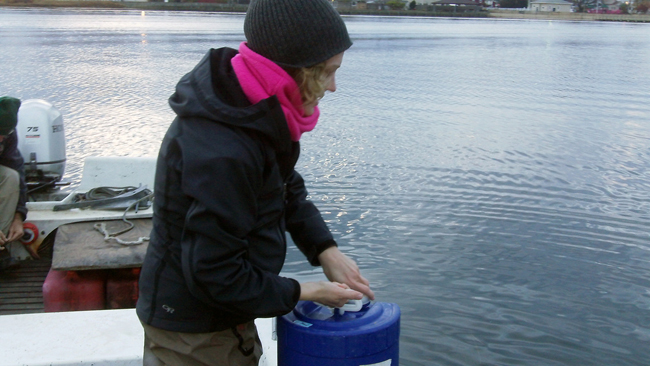
Denise Bruesewitz gets additional water from the site that will be used to run the experiments.
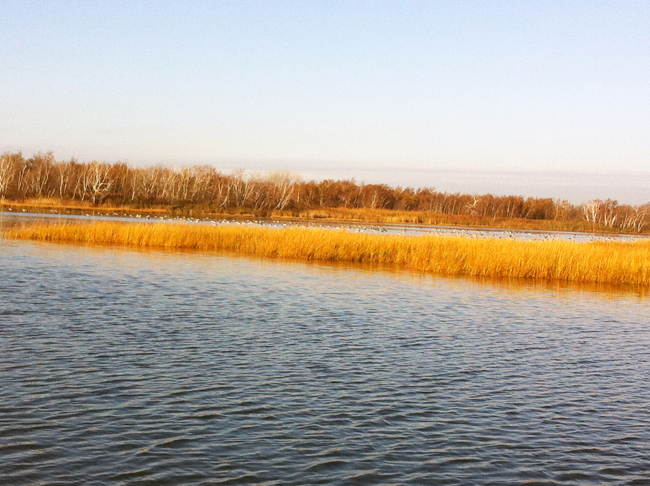
Nitrogen from the sewage treatment spurs the growth of Ulva which now grows year-round in the estuary. Migrating brants take their full, but mats of this dense seaweed are often found in various stages of decay, creating odors that some people mistake for the odor of untreated sewage.
When operating at full capacity, the Bay Park Sewage Treatment Plant is capable of only secondary treatment, which leaves high nitrate levels in the wastewater effluent. Nutrient-rich wastewater is likely a major contributor deteriorating water quality and eutrophication in WLISS, which has resulted in large phytoplankton and Ulva blooms. It also causes hypoxic conditions in areas with restricted flushing such as Hewlett Bay.
Back in the skiff, Chester used a longer PVC pipe to get some samples from the intertidal sediments (mudflats). Then Jim motored us out a little further to get the subtidal channel sediments. With each core coming on board, the three researchers worked quickly to secure each sediment and water column core. The undisturbed cores will be brought back to the laboratory under dark conditions and used for measurements of nutrient and gas fluxes and sediment hydrogen sulfide, and dissolved oxygen profiles.
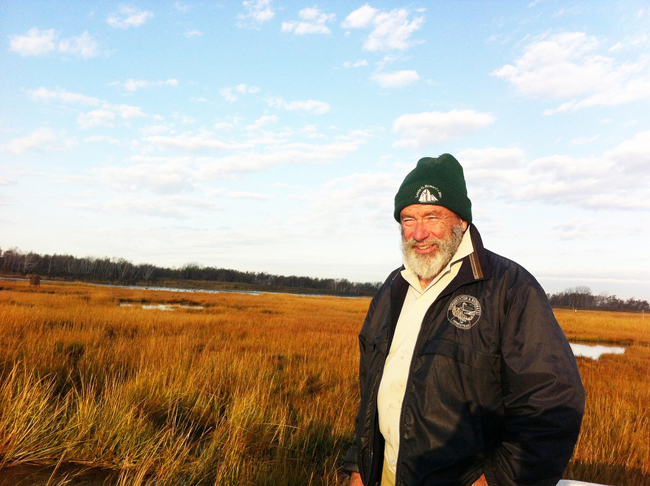
Jim Browne, conservation biologist for the Town of Hempstead, provided transportation and running documentary about these waters for the research team.

Chester Zarnoch wields a long sampling tool with aplomb to get down to the subtidal zone.
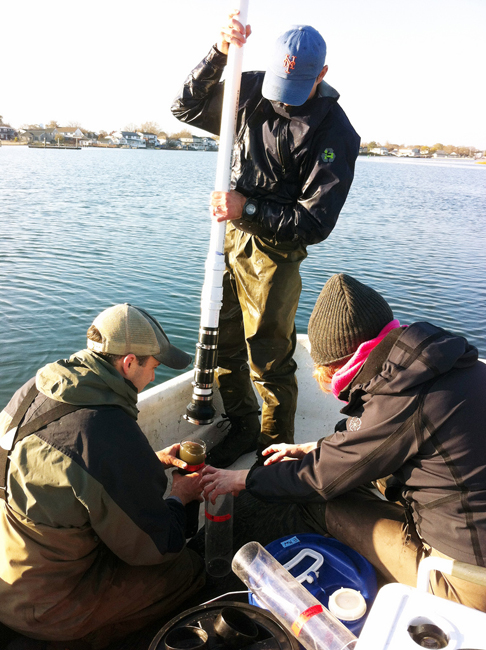
Chester, Tim and Denise work together to secure the samples in the tight quarters of a small skiff.
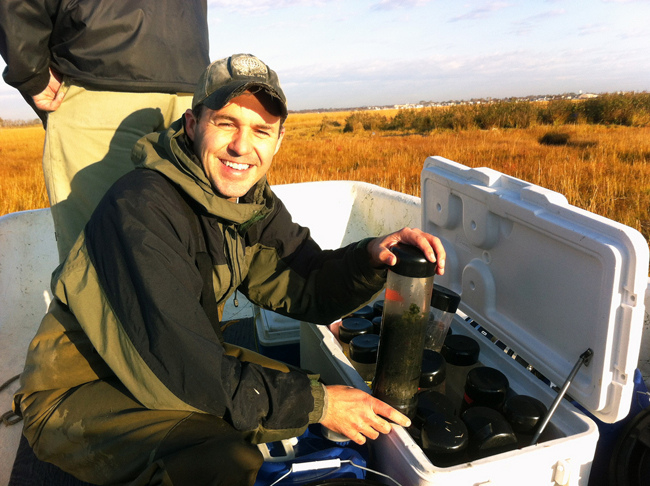 Tim Hoellein
Tim Hoellein secures the samples in the cooler as we leave the sewage treatment plant.
By sampling in each season, the researchers have already seen some trends. Ecological impacts of the sewage release were likely moderated because Sandy damage occurred at the end of October 2012 when water temperatures were relatively low and dissolved oxygen levels were high. If a similar event were to occur in August or September (as occurred with Hurricane Irene in 2012), when water temperatures and sediment respiration rates are higher, there may have been more severe impacts on the ecosystem leading to hypoxia.
Once all the samples were secured, we left the environs of the sewage treatment plant and headed for the same control site that has been used to compare data from the salt marsh near the plant. On the way we passed a few sites that indicate that infrastructure damage from the storm is still evident a full year after Hurricane Sandy.
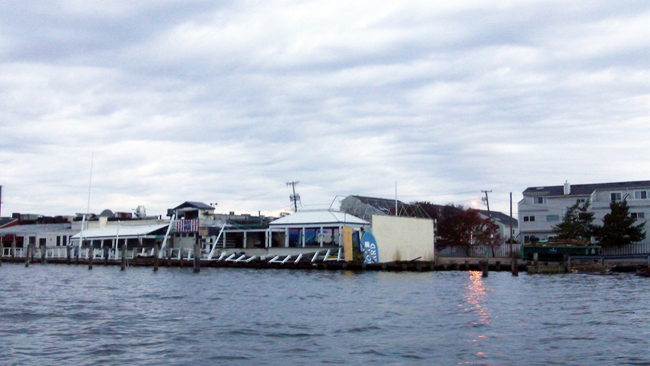
(
pictured above, below) Along the estuary close to where the outfall pipe for the plant carries
its effluent, damage left in the wake of Superstorm Sandy is still
evident over one year later.
As we headed to the control site in Jones Inlet, Cuba Island, we saw a
few harbor seals—all within view of Jones Beach amphitheater and the
outline of the Jones Beach water tower—a familiar sight to anyone who
grew up going to Long Island’s beaches.
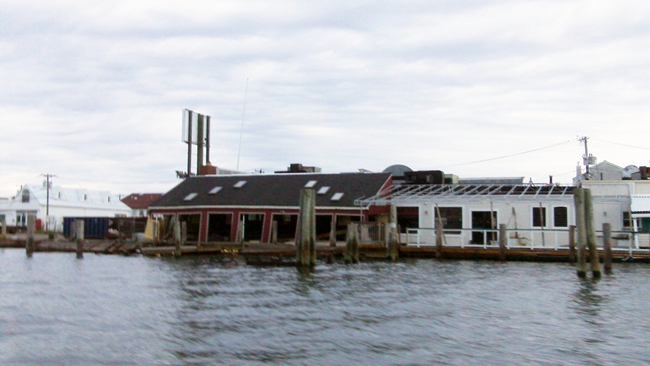
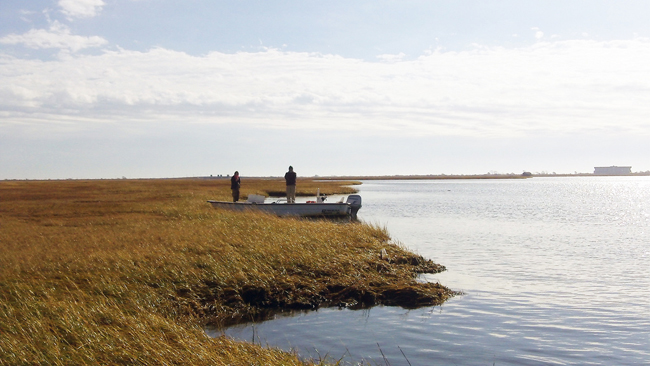
Anchoring at Cuba Island
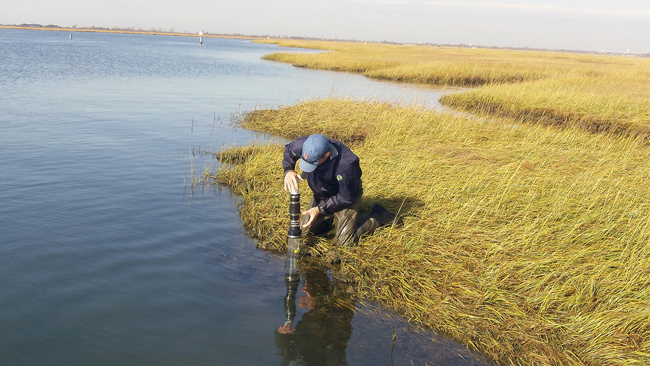
Chester sampling on Cuba Island ... Cuba Island is not much of an island, but rather a small patch of salt marsh and amazingly, Chester found a marker he’d put in place back in the summer. Again, three types of core samples were taken: salt marsh, intertidal and subtidal zones. By now, the sun was high with clouds scurrying across the sky. The day had grown much warmer—a good thing we’d postponed the trip from the day before when there were storm clouds and strong winds resulting in small craft warnings.
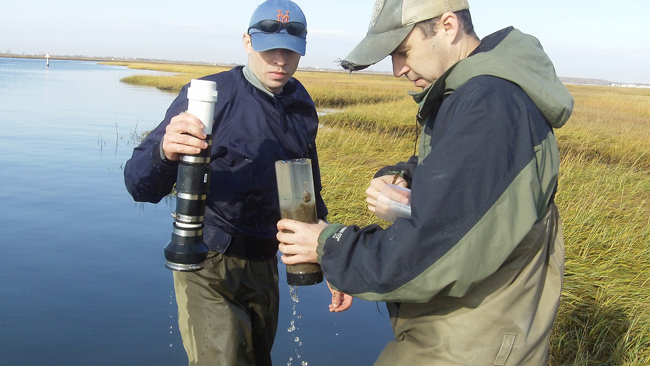
(
pictured above, below) Chester and Tim work together to secure the sample.
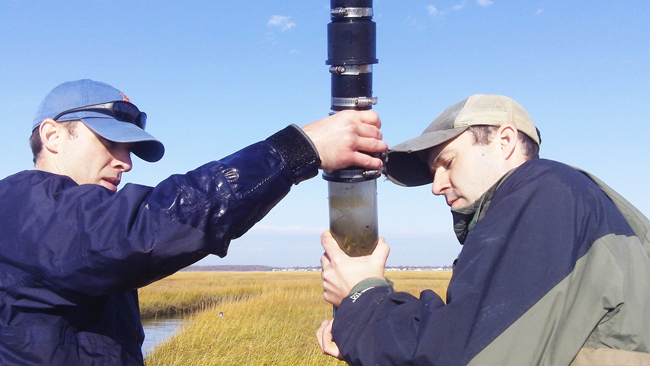
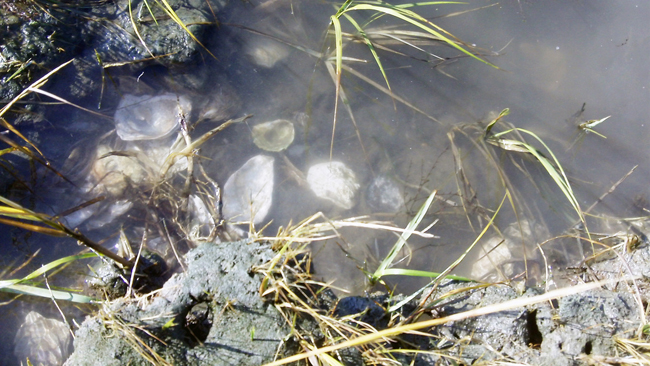
An intertidal pool reveals a healthy oyster population.
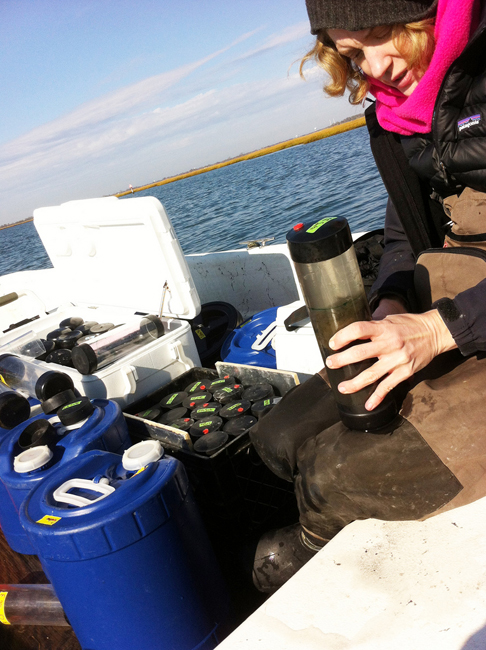
Denise labels the Cuba Island samples.
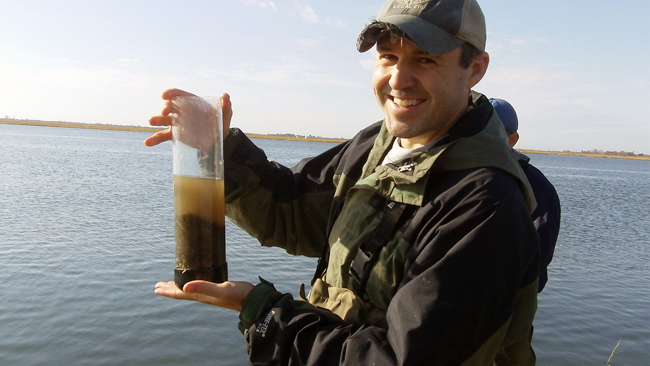
Tim with one last sample.

Tim pulls up the anchor from Cuba Island ... Back at the marina, the coolers filled with samples were loaded up for a trip to the laboratory. The investigators still had a few hours of work left running the tests. But they have already been seeing that the nutrients and decomposition of organic material associated with the Sandy sewage did not result in abnormal dissolved oxygen, phytoplankton abundance, or nitrate concentrations at the impacted study site in Island Park. This suggests that sewage and nutrients were likely flushed out of the estuary before degrading water quality. Alternatively it may suggest that this site, which is chronically enriched with nitrogen (N), may be influenced by other nitrogen inputs (i.e. creeks or non-point sources) rather than the effluent from the plant. Managers need to emphasize ecosystem protection when developing storm mitigation strategies for late summer hurricanes.

Back at the marina, the researchers are all smiles at a great morning’s work. Now the samples get loaded into the van and experiments run back at the lab.

We say goodbye in the marina parking lot and I had to give the waders back!
Preliminary evidence suggests salt marshes play a significant role in nitrogen removal in the WLISS estuary. In other words, the salt marsh has handled the onslaught of nitrogen that resulted from the plant’s disruption. These habitats provide conditions, such as reduced sediments and ample organic carbon, which supports the microbial conversion of reactive nitrogen in the water to harmless nitrogen gas that leaves the ecosystem. Conservation of existing marshes and restoration of degraded marshes should be a management priority in the WLISS estuary. Managers may also want to explore potential restoration of other structured habitats, such as oyster reefs and eelgrass beds, which may also provide the benefit of nitrogen removal as well as other ecological functions.